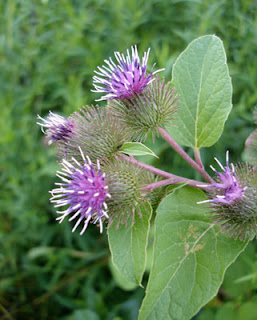 |
| Burdock (Arctium lappa) Flowers |
Arctium lappaFew plants make me think of being a kid more than burdock. As a kid I spent a lot of time at my grandparents' dairy farm. Like most old farmsteads, plants like burdock, stinging nettle, cleavers, and catnip grew with wreckless abandon. These plants were most likely unbroken links to plants that were purposely planted by farmers and their families generations ago. My siblings, younger cousins, and I were left to our own devices for long summer days. Besides simple games like hide-and-seek or freeze tag, the natural resources were a great source of amusement. Hollyhock flower fairies, willow whips (good not only for "smacking" each other but for flinging green plums over the barn roof), climbing trees, eating wild berries, and of course, playing with burdock. The gigantic leaves leaves made great fairy and "wild man" hats and clothes. The burs could be made into mats and balls. Oh....the burdock balls. Those old balls could be thrown at a sibling or cousin and they would stick - just like the Velcro-based dart tag type items today. It was all "fun and games" until someone got one of the balls in their hair and went tattling to an adult.
Arctium mimus
 |
| Arctium lappa leaves |
For medicinal purposes the stems, roots, and seeds ("niu bang zi") are generally used. In Western herbal medicine burdock root is typically used internally for skin diseases and inflammatory conditions due to chronic toxicity. In Traditional Chinese Medicine, the seeds are used for these similarly as well as to treat colds, pneumonia, and throat infections. [Source: The Herb Society of America New Encyclopedia of Herbs & Their Uses By Deni Bown]
In Kampo, a Japanese form of herbal medicine, burdock seed is a "cold, pungent, and sweet herb" that detoxifies tissues by encouraging the circulation of qi. The seed dispels heat, relieves swelling, and normalizes breathing. It is also used in formulas for coughs, rashes, and sore throats. [Source: Japanese Herbal Medicine: The Healing Art of Kampo by Robert Rister]
Herbalist James Green says that burdock is a "deep food and and alterative that moves the body to a state of well-nourished health." He also notes its use for a variety of skin conditions (incl. eczema, psoriasis, dermatitis, boils, rheumatism, gout), aids appetite/digestion, and in poultices. [Source: The Herbal Medicine Maker's Handbook by James Green]
Burdock roots and stems are also very good foods. The stems can be prepared like cardoon. The roots are popular in a wide range of Asian dishes - one of the most well-known being the Japanese dish kinpira. My personal favorite is my own version of tsukemono (Japanese quick pickles) with burdock root. Not only do I love the unique taste of these pickles, I like to make them whenever I'm feeling "low" and need a boost to my energy and vitality. Here's my recipe:
Sweet Vinegared Gobo (Burdock Root)
Gobo (burdock root)
2 Tbsp sugar
2 Tbsp lemon juice
1 tsp salt (sea salt preferred)
4 Tbsp rice wine vinegar
1. Wash gobo well. You can peel the root first if desired but this is not required especially for the thin-skinned cultivated roots found in Asian markets. Wild-dug roots are best peeled. Half or quarter root and cut into 1-2" sticks.
2. Boil root 2-3 minutes. While root is boiling, mix remaining ingredients.
3. Drain root and add hot to the marinade. Refrigerate and cool before eating. Best flavor if sat overnight. Keeps 3-5 days in refrigerator.
When asked about my favorite herbs, I usually tell people that my foods are my favorite herbs because I live Hippocrates' quote, "Let food be thy medicine and medicine be thy food.” Burdock is one of those healthful herbs that can make it to my dinner plate.
